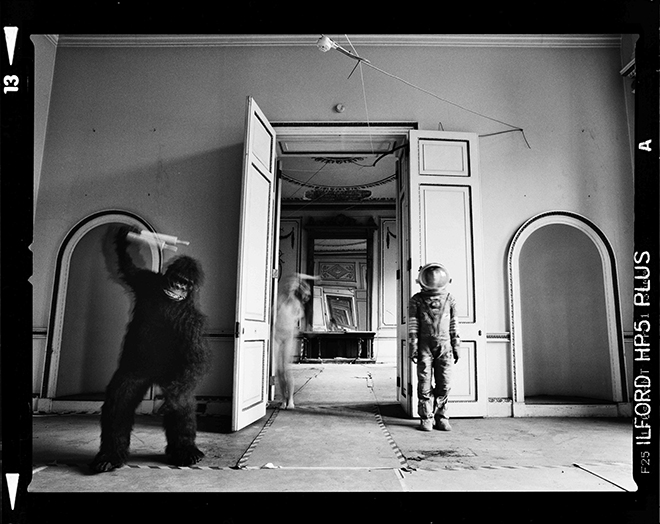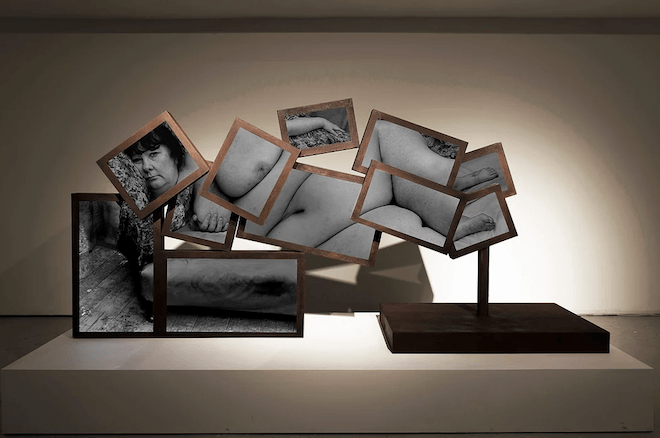‘I like the idea of turning the tables, subverting the male gaze. Sue is now looking at us.’ says Charlotte Colbert, the London-based artist behind one of the must-visit exhibits at Photo London this year.
Her work ‘Benefit Supervisor Sleeping’, 2017, offers a life-size image portrait of Sue Tilley, Lucian Freud’s iconic model. While creating an overall survey, the work alerts viewers to specific details such as Tilley’s foot or the paint spattered studio floors that Tilley was first painted in.
Photo London is at Somerset House 17th – 20th May 2018. See the full programme here.
Feature image credit: Charlotte Colbert, ‘Benefit Supervisor Sleeping’, 2017
Tags: Charlotte Colbert, Photo London
Filmmaker and artist Charlotte Colbert is one of those women that make you feel very dull, and impossibly unaccomplished, by comparison. From the outside looking in, her world seems one of perfection. She’s beautiful yet effortless, undoubtedly talented, boundlessly intelligent – and to all intents and purposes, managing to live by doing what she loves, which is – and let’s be honest, always has been – something of a rarity.
Emerging as a master of the surreal narrative, Charlotte’s work has documented everything from faces obscured with giant ’emoji heads’, to the stripped-back grace of nude figures in a former lesbian commune in East London. Her aesthetic is ethereal but not whimsical; there is real, transportive substance there, in among the solitary figures and exquisitely desolate surroundings, you can see relatable and raw emotion.
Ahead of her upcoming shows – one solo exhibition at Gazelli Art House, and another group exhibition to celebrate the genius of Kubrick at Somerset House – we caught up with Charlotte to delve a little deeper into her creative process.
You’re described as a filmmaker and artist – which did you embark on first? And how?
I’ve always been interested in stories and ever since I can remember I’ve been collecting them, putting them down in strange formats, inventing them. As a teenager I’d spend all my nights just wandering through cities talking to people, vagrants, partygoers, down-and-outs and up-and-comings. And when asked what I wanted to do and who I wanted to be, all I could ever think of was the desire to be everyone, to experience life from as many different perspectives as possible. I’d always been scribbling down people’s stories, taking their pictures and little by little it got more formal, not in the sense of square but in the sense of shapely, and the stories started articulating themselves over longer formats as I wrote screenplays for people, and the photographs moved away from documenting, becoming more staged as I tried to capture what had settled in my head rather than what I could immediately see.
How does each discipline differ in terms of inspiration through to execution? Do you have a preference?
Photography is much quicker. It creates little windows into other dimensions and although there is a whole world there, the viewer only gets glimpses into it. Whereas in a film all the details of the world have to be thought out and solved because both viewer and performer will actually inhabit it together for a specific length of time.
In a fine art work only the artist needs to fully understand and believe in the world of its fiction whereas film is much more collaborative and everyone needs to fully inhabit it while making it and viewing it. An actor will need to incarnate a character and for that to happen that character needs a fully fledged logic, language, body language, imaginary world, family situation, back story, quirks etc.
If you create a crazy looking Chewbacca type creature, the writer will know how that monster goes to the toilet, because, even if it doesn’t feature in the film, it will be necessary to the believability and the coherence of the fictional world.

For your participation in the upcoming Kubrick exhibition at Somerset House, you’ve referenced A Space Odyssey – was this something that you chose or was it assigned to you? Can you remember when you saw the film first? What kind of feelings did it leave you with?
A while back I wrote a screenplay on Lou Andreas Salome, a really interesting writer and intellectual who at the turn of the 19th century wanted to live her life, controversially at the time, in a free spirited, independent, thoughtful way. She became well known for her collection of lovers, from Nietzsche, the young poet Rainer Maria Rilke twenty years her junior, to Freud. During the research, I became quite touched and fascinated by the character of Friedrich Nietzsche – this half-blind, hunchback, outcast of a man who strove the be the Ubermensch, the ‘SuperMan’. He wrote this amazing book called Thus Spoke Zarathustra, which strongly inspired 2001 A Space Odyssey. Kubrick said: “Somebody said man is the missing link between primitive apes and civilized human beings. You might say that is inherent in the story too. We are semi-civilized, capable of cooperation and affection, but needing some sort of transfiguration into a higher form of life. Man is really in a very unstable condition.” It’s that fragility and the desire to overcome it that I was interested in exploring further.
I’ve read that in that work you wanted to explore the astronaut “caught within the limitations of being human” – where there any limitations in particular that you had in mind?
For the Kubrick show I wanted to recreate an odyssey but rather than sending the lone figure of the astronaut into space, I decided to send her to explore our past. The images were shot in the former site of the infamous In and Out Club on Piccadilly. I was interested in the juxtaposition between the astronaut, symbol of the future, symbol of Man’s power to surpass, and this totally decayed building of faded grandeur. The Astronaut, an iconic reference to exploration, the overcoming of nature, the constant attempt to push back the boundaries of our condition, here wanders, tiny and humbled by history and time, through the large, gilded and abandoned rooms. Both the building and the astronaut seem united in their solitude. However grand the quest, however beautiful the endeavor, we can’t escape time and the limits of our own humanity – loneliness, despair, short-sightedness, the need to be loved, sores, our temporality, itchiness, our physicality, our ailments, diseases etc.
Your work has a beautiful ability to be both introspective and yet outward looking at the same time – from ‘A Day At Home’ to the endless expanse of the universe – do you identify with one trait more than the other?
As we haven’t yet developed a way to experience that isn’t human or at least from a human perspective, it feels the world as we perceive it is only ever a mirror to our interiority. They seem to exist in and within each other. When I took the space images, I double exposed them with images of the galaxy and images of cells from our bodies. And it was amazing how similar looking they were. The macro and micro like mirrors. Both containing infinity.
Derelict, empty buildings have featured in your work on more than one occasion, what is it that they say to you? Are your surroundings important to you on a daily basis?
I love derelict buildings. The sense of adventure and discovery at finding them. The putting together of all the pieces and clues to build up a mental image or story of what happened in the space. Derelict buildings are like the architecture to a story. They contain past lives, dreams, loves, hurts all washed away by time. They are like memento moris.
Is there anything in particular reaction that you want people to have to your work?
It depends on the piece – if it’s a film a photograph, a script. But hopefully some kind of feeling. Of solitude, eeriness, a little window into a different world.
How do you feel about the future? Does it scare or inspire you? What are you working on next?
The future scares and inspires me. I’ve got a wee show coming up, ‘Ordinary Madness’ at Gazelli Art House, playing with the idea of our relationship to digitalisation, and am working on a new series of photography on the theme evolution and a feature film, which I am writing, and will be directing.
Charlotte Colbert’s solo show Ordinary Madness opens at Gazelli Art House 1st July, as well as group show Daydreaming with Stanley Kubrick at Somerset House on 6th July
Charlottecolbert.com
Tags: Charlotte Colbert, Daydreaming, Ordinary Madness, Somerset House, Stanley Kubrick





 Twitter
Twitter
 Tumblr
Tumblr
 YouTube
YouTube
 Facebook
Facebook
 Instagram
Instagram
